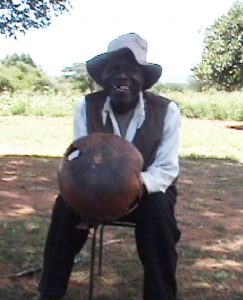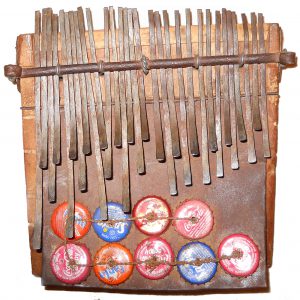A very different Shona mbira
Among Zimbabwe’s many types of mbira, the mbira dzaVaNdau is an outlier. Even the name, mbira dzaVaNdau, exists primarily to distinguish it from its more widely known cousins. It means the mbira of the Ndau (sub-group of the Shona), but for those Ndau men who play, it is simply mbira. The dzaVaNdau qualifier is accurate, as this instrument is played almost exclusively within Zimbabwe and Mozambique’s Ndau-speaking communities. It is a secular, solo instrument used by Ndau men to accompany songs during drinking sessions, social gatherings, and other informal occasions. Thus its purpose is quite distinct from other Zimbabwean mbiras used in ceremonies.
Listen to Davison Masiza playing Shandira on mbira dzaVaNdau, recorded by Tony Perman in 2005:

Location
The Ndau live on both sides of the Zimbabwe-Mozambique border. While closely related to other communities within Zimbabwe’s Shona majority, the Ndau are distinct historically, spiritually, politically, linguistically, and musically. Much of this distinction emerged following decades of occupation from the armies of the Gaza Nguni, who fled Shaka’s military advances in present day South Africa under the guidance of Soshangane. They settled in the Ndau-speaking areas and shaped local life considerably. The mbira dzaVaNdau likely predates this history but now reflects many of the musical characteristics reflective of this southern influence. This, and the fact that it was never required to meet ceremonial expectations, has led to a less coherent repertory of pieces, with a wide range of forms and rhythmic characteristics.

Instrument construction
The mbira dzaVaNdau has its lowest bass keys on the left and the highest keys on the right. It can have anywhere from 20 to 34 keys arranged in 5 manuals of keys (three on the left and two on the right). Unlike the mbira “dzavadzimu”, it relies on a 6-note scale (hexatonic) that is widely idiosyncratic. Because it is a solo instrument, there’s no need for shared scales.
Repertoire
Songs are often very short, harmonically static, and rhythmically ambiguous or complex, ranging from a single 3-beat phrase (of four pulses each) to a complex four-phrase, 128-pulse piece. Most pieces are two phrases of 3 or 4 beats, but can be either based on triplets or duple beats. Like the Ndau scales, forms and rhythmic patterns are also diverse.
The performers themselves often create songs with autobiographical texts or social commentary.
Performance
Players usually place the mbira inside a resonator made from a gourd or sheet metal called a deme. They play alone, improvise at high speeds, and entertain those around them (often in exchange for beer or distilled liquor).
Part of rural life
While the mbira dzaVaNdau has faded from formerly more widespread use in recent decades, it still remains a vibrant part of rural Ndau musical life on both sides of the border.
More information
For more information on mbira dzaVaNdau, contact Tony Perman.
This page was written by Tony Perman, edited by Erica Azim.
